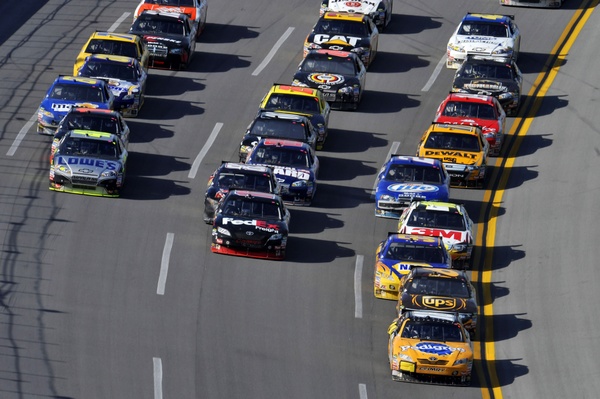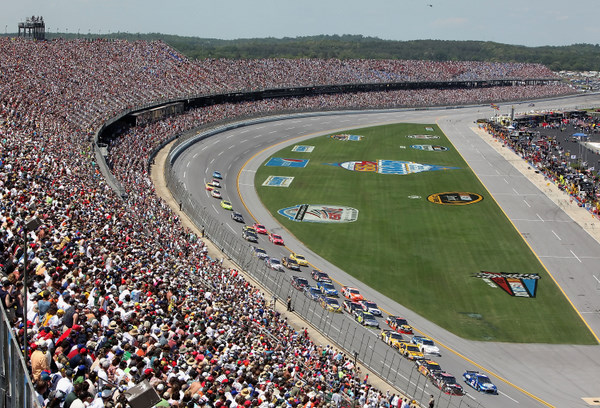And now NASCAR's Take: A fluke crash? Everything worked correctly? Drivers themselves to blame?

Talladega Superspeedway: It's biggggg, it's baddddd, it's fast, and it's scary. Is it safe enough? (Photo: Getty Images for NASCAR)
By Mike Mulhern
mikemulhern.net
Safety is NASCAR's top priority, NASCAR executives said Monday afternoon in a press conference to discuss Sunday's flurry of accidents, particularly the Carl Edwards-Brad Keselowski crash on the last lap in which Edwards' car became airborne and ripped through part of the frontstretch safety catch-fence.
The NASCAR men, attempting to lower the tone of the Talladega debate and try to defuse the volatile issue, appeared to be pointing to the drivers themselves, all in the field, as the men who are ultimately responsible for what happens on the track.
And NASCAR appeared to consider the Edwards' car getting airborne almost a fluke. They said they appeared satisfied with how the roof flaps deployed.
Jim Hunter, NASCAR's top PR man, said "it's extremely unfortunate that a few fans suffered minor injuries. No one wants anyone to get hurt while attending one of our events, and our thoughts are with each of the fans injured this weekend."
And he then repeated that "safety is, and always will be, NASCAR's number one priority.
"We are glad that each of the safety devices at Talladega yesterday worked properly, including the roof flaps and the catch-fence.
"We are constantly evaluating safety initiatives.
"We tried letting the competitors police themselves when it comes to blocking and bump-drafting.
"After reviewing all of those procedures, we might have to start making some judgment calls and issue penalties for drivers who blatantly block and abuse the bump-drafting.
"We are going to take whatever measures we need to in order to ensure the races are as safe as possible for everyone."
Robin Pemberton, NASCAR's vice president for competition, said both Edwards and Keselowski shared blame for the crash. But it was unclear just how NASCAR might judge blocking or aggressive driving.
"Carl was doing everything he could to try to maintain first place…and the guy trying to win the race was running second," Pemberton said. "Sometimes they come together, trying to win a race -- whether it's Martinsville or Talladega.
"I would say they both have some ownership in it."
Hunter conceded that there could be questions about safety, with seven fans being injured in the incident: "One of our primary goals over the years is to build a restraining fence that keeps the cars and parts and pieces out of the spectator areas.
"Nothing is bullet-proof.
"From what we saw yesterday, the retaining fence did what it was supposed to do -- it threw the car back on the race track.
"There was some debris that went in the grandstand, that fortunately did not invoke serious injury.
"So we will analyze the fence and make sure that it did what it was supposed to do. We think it did.
"If there's something we come up with -- as we analyze this accident -- we will certainly put it into play.
"We will make it as safe as we humanly can."
Edwards' car got airborne when it turned around, and Ryan Newman and Dale Earnhardt Jr. both said NASCAR needs to reexamine the roof flaps and other devices designed to keep a car from getting airborne in any such situation.
"Actually this car is better than the previous car," Pemberton said about the issue of 'flying.'
"When you look at the 99 car (Edwards), the roof flaps deployed as it got turned around, and the car started to set back down, and then the 39 (Newman) hit it.
"It punted the 99 car, and that's what got it up into the fence."
A freak one-two punch?
"Quite frankly, these situations that come up from time to time are a one-off -- things that you don't necessarily foresee, and they are hard to recreate," Pemberton said.
"We will evaluate everything the best that we can."
Even changing the configuration of the track? Perhaps flattening the banking, to force drivers to back off in the corners, like more traditional tracks?
"Flattening the racetrack, sure, that would put us in a situation where you could run without restrictor plates," NASCAR's Cup director John Darby said. "But I don't see that as a real viable option.
"The speed of the cars remains safe (at Talladega).
"The most exciting races we have today are both at Daytona and Talladega. That's a big part of our sport.
"I think there's more value in continuing our safety efforts at those tracks than turning those two very historical, very exciting racetracks into flat parking lots.
"Talladega and Daytona are not the only racetracks that we have wrecks. Talladega and Daytona are not the only places that we have multiple car wrecks. But I think for some reason there's always a temptation to sensationalize the wrecks at Daytona and Talladega way beyond what happens at Lowe's Motor Speedway or Atlanta Motor Speedway or any of the other tracks that we race on.
"It's always easy to fix a perceived problem by running away from it or throwing it under a rug, but I don't think that's our approach in this situation."
Edwards' crash was the weekend's second flipping crash. But Pemberton said that Matt Kenseth's crash Saturday was different: "When Matt's car turned, what made that car turn over wasn't air. It rolled over.
"That car really never left the ground until it started to roll.
"I don't believe his flaps came up until he was either sideways or almost upside down.
"So Matt's situation was way different."
Are Talladega's fences high enough? Should fans be barred from seats so close to the track?
"I think the fence was plenty high, but we'll go back and look at some other things -- whether it needs to be reconfigured or not," Pemberton said.

There's always plenty of three-wide action at Talladega....but maybe the cars are actually too slow. If they ran faster, maybe the field would spread out more (Photo: Getty Images for NASCAR)
NASCAR's yellow line out-of-bounds mark at Daytona and Talladega has been criticized by some for creating bad situations. Darby disagreed: "The yellow line rule itself has been very effective in controlling some of the huge wrecks we used to have.
"The yellow line rule has at least made the width of the racetrack consistent all the way around, so the competitors know how much real estate there is there to use.
"The relationship of the yellow line rule and what happened Sunday I think, although it's been pointed at, I firmly believe in my own mind that if you move both cars up two lanes on the racetrack, the same wreck would have happened, and the results would have been very similar."
Danger?
"Driving down the interstate has a degree of danger," Darby said.
"Everything we do in life does.
"Our responsibility -- understanding that any sport has a degree of danger -- is how you protect your participants and your fans the best that you can.
"And that's what we do, and we do it every day."
© 2010-2011 www.mikemulhern.net All rights reserved.
Web site by www.webdesigncarolinas.com







Darby sounds almost like Bud
Darby sounds almost like Bud Selig saying "steroids are not a problem in baseball" some 4 years ago. Carl Edwards may have sensationalized things with his answer yesterday, but he was not far from the truth in what he said.
Reply to comment
Edwards was wrong. We've
Edwards was wrong. We've spent the last two decades going through driver deaths and injuries on intermediate tracks and short tracks, and even with the SAFER, the HANS, etc. chances are at some point we'll hit another such spell of tragedy - Denny Hamlin's concussion at Talladega last October showed these things aren't foolproof, and Sterling Marlin's near-fatal neck injury at Kansas in 2002 (with the HANS) plus Jerry Nadeau's near-fatal crash at Richmond (also with the HANS) further shows that we as a sport get hung up on spectacular happenings at Talladega yet it is the "safer" tracks that are the real threat.